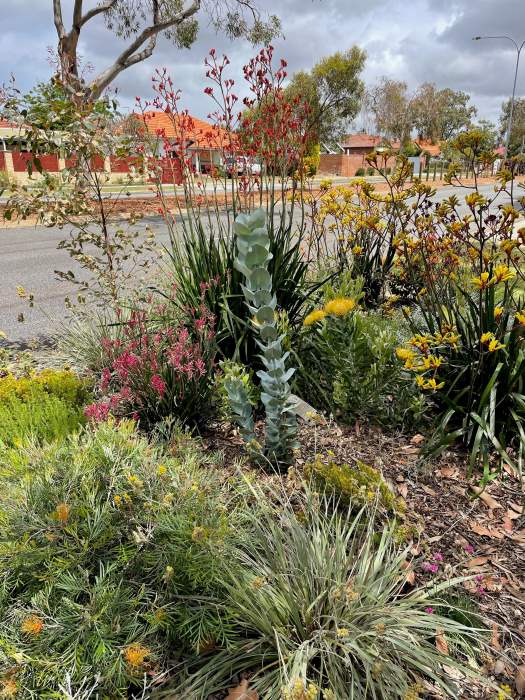| item(s), Total: $0.00 View Cart |
| Shopping cart is empty. |
Welcome to November - the rapid race to end of year activities & Christmas has begun!
Now's the perfect time to be getting mulch on your garden - while the soil is still a little damp (hopefully!) and before the temperature climbs into the 30's regularly. We stock a wide range of mulches suitable for vegetable gardens, ornamental gardens and natives - ask us for advice! For those of you who love the Moon Planting Calendars, these are on their way - we should have stock within a couple of weeks. They make great gifts for gardening friends & family; so why not grab one for you and one for a friend?
Recently Paul & I were invited as guests on the LIAWA (Landscape Industry Assoc of WA) new podcast - "Green Thumbs Up" - the episode is live; if you'd like to have a listen - the link is here!!! The interview is about how we got started 20 years ago & what the business of GLSC is all about today. Enjoy! We hope to see you soon @ The Green Life Soil Co Linda & the Team In this newsletter:Jobs for the November garden Jobs for the November garden
Get your herbs going! Many herbs respond to the warmer weather; plant them into improved soil and water regularly to be enjoying fresh & flavourful herbs for your summer entertaining & Christmas cooking. If you're wanting to give potted herbs (or potted colour) for Christmas gifts - now's the time to select your pot, choose your gift, and pot it up. Look after it and by the time Christmas comes along it will have settled into its new pot, and be looking lush and lovely - ready to give away. It's the PERFECT time to plant Basil - fabulous companion plant and flavour partner to your tomato crop.
Once you start back with regular retic, remember that regular watering is important to prevent stress (where plants may drop their forming fruit) and fruit splitting from over watering. It's true we can't do much about rain at inopportune times of fruit growing (ask any orchardist) but we can prevent the same result from inconsistent watering. Blossom end rot is also a condition many summer vegie crops get (especially Tomatoes and Capsicum) - also caused by irregular watering - so whatever your regime is, stick to it as much as possible.
Crops in pots - if you have miniature fruit trees or vegies in pots, remember to feed them regularly; but little and often is the best way. Use a light dose of a slow release or granular fertiliser every 3 months (don't be heavy handed! - use way less than the recommended annual or 6-monthly dosage), and you can give it a light liquid feed with kelp, worm wizz or fish once a month. Mulch pots in summer and check regularly to ensure that your watering regime is adequate. What to Plant Now
Globe artichokes, Asian greens, Basil, Beans (Snake beans are a heat loving variety), Beetroot, Capsicum, Chilli, Carrots, Celery, Choko, Cucumber, Eggplant [pictured right], Ginger, Jerusalem artichokes, Leek, Lettuce, Melons, Mint, Parsley, Parsnips, Pumpkin, Radish, Rocket, Rosella, Silverbeet, Spring onion, Squash, Strawberries, Sweet corn, Sweet potato, Tomato, Zucchini. Whether you're after seeds or established seedlings, we have lots available. Come and see us for advice and all you need to have a fabulously productive garden. Fungal diseasesAt this time of year, and especially after the rains we've had recently, we're finding Powdery Mildew is causing problems on peoples young plants - it's particularly a problem with cucurbits (zucchini, cucumbers, pumpkins, melons, etc.) as well as grape vines, strawberries and some ornamental plants like roses. The disease starts off as white spots on the leaves (sometimes the spots turn yellow) and usually affects older leaves first. The disease generally weakens your plants, and can affect yield greatly - so it's best to treat your plants early to minimise impact. Remove any badly affected leaves and bin them; making sure you wipe down secateurs to avoid spreading spores. Watch your watering - in the morning (instead of the evening) is recommended, as it gives the leaves a chance to dry off as the day warms up. Use a simple spray of 1 part full cream milk to 9 parts water and spray over susceptible leaves. Another option is 1 flat tablespoon of bi-carb, 1 tablespoon of vegetable oil, a few drops of dishwashing liquid in 1 litre of water, shake to combine, and spray. Both these methods make the leaf surface less susceptible to fungal growth, and can be applied weekly as a preventative. Ensure good airflow around your plants, and if any leaves are badly infected, remove and bin them, as spores can spread and infect healthy growth. Avoid using when very hot weather is forecast - any spray that contains oil can cause leaf burn in strong sun. Garlic, Chamomile and Chives are all mildly anti-fungal too - so make tea and use as a foliar spray. VIP Special (and NEW product arrival!)
Mineral Magic works a little differently to clay and biochar; and would be a great additive to those ingredients or used on its own. Like clay & biochar, being a mineral product, it won't degrade for many, many, many years - so effectively incorporating it to your garden needs to be done just once. It is a completely natural product sourced from WA - certified organic and smart watermark and water wise approved. A number of Shires, golf courses etc. are now using this product and reporting healthier turf and reduced water and fertiliser use. We're giving our VIP customers an opportunity to try Mineral Magic for themselves, at reduced prices this month (while stocks last). We have stock of both lawn and garden grades in 10kg and 20kg bags. Pricing for VIP is: 10kg VIP special = $35.50 (usual price is $44.50) Special is valid while stocks last or until close of business Saturday, 4.12.21. So come and grab some, and try it for yourself - this is the perfect time to get garden beds prepared before summer! If you'd like more information on the product, application rates, etc. See their website: www.mineralmagic.com.au Strawberry Success
In Perth, we can grow them pretty much year-round. They bear two crops - a sweet summer crop just in time for Christmas pavlova topping, and a mid winter crop, which is usually a little smaller but still always welcome. Plants are available from some nurseries as runners - usually in Autumn. Otherwise, they can be grown from seedlings/pots found in nurseries, or sometimes even from seed, although these tend to be the smaller Alpine Strawberries. (Very sweet, but tiny fruit.) Most of the year, you'll find pots & plants available. There are many varieties - some white flowering; others pink flowering. All strawberries like a sunny position - although in Perth that can mean they suffer in the extremes of January/February, and they'll do better under a bit of shade, or with only morning sun in the hottest time of the year. They also like rich soil - prepared with compost and aged manures and worm castings prior to planting. A handful or two of Blood & Bone and rock dust is good too. Strawberries have a preference for neutral to acidic soil; although in my own experimentation, they did better in our Premium Potting Mix than in the more acidic Blueberry Mix - which was a bit of a surprise to me. (If you're using our premium potting mix - there's no need to use the other additives I've mentioned.)
Strawberries need good airflow - ideally, plant 20 - 30cms apart. Mulch well (straw, pea straw, sugar cane or lupin mulch is ideal) to protect the roots. Plants are susceptible to a number of fungal diseases, including powdery mildew. Avoid overhead watering if possible - drip irrigation or wicking beds help with this. Watch for discoloured leaves (with striping or blotches) and if you suspect disease is spreading, remove and dispose of affected plant material. To ensure larger, redder (it's true) and nicely shaped strawberries, good pollination is essential. (Misshapen berries are often a result of insufficient pollination.) Bees, beetles, flies, ants and wasps will all help with pollination - so another reason why biodiversity is important in your garden! Attract pollinators with a wide range of flowering plants and your strawberries (and other fruiting crops) will benefit.
When transplanting runners, make sure to keep the crown (growth point) just above ground level to avoid it rotting. Crop rotation is important - refresh your potted soil or transplant your patch to a different part of the garden after a couple of years. It's best to avoid areas that have just grown tomatoes, capsicums, eggplant or chilli plants. Fertilise your new plants with kelp to help with transplant shock. Light liquid feeding around plants every few weeks and a handful of potash will help with plant vigour and fruit set - avoid excessive nitrogen as you'll get leaf growth over fruiting - it's always a balancing act - but once fruit is forming, cut back on watering just a little to intensify the fruit's flavour. How many Strawberry plants do I need? Photo Competition
This month we've gone away from vegie gardens to a really impressive verge makeover. Thank you to June who sent in pics of her native waterwise verge garden in Bayswater - which I'm sure you'll agree, is rather show stopping at the moment. It's taken a couple of years to get here - so it's a reminder that nature takes time; so start today, be patient, and the rewards will come. June has this to say about her garden: "This is my verge that I planted two years ago using Green Life Soil Native Mix. Really proud of how far my kangaroo paws have come!. I’ve been waiting super patiently for my front native garden to be established so I’m beyond thrilled about this :) but it’s really thanks to you guys and I really appreciate the free delivery because I didn’t have a car until a year ago. My garden wouldn’t look anywhere this good otherwise. I had a much higher success rate with tube stocks by adding a few handful of your native potting mix prior to planting :) Keep up the great work!" Thanks June for sending in your photos - scroll to the foot of this newsletter to see another view of her garden. Retailer UpdatePlease support your local independent retailer who supports us! The specialist retailers listed here will be happy to give you gardening advice and help you with our products - please call to check what lines they carry. We'd like to welcome a new stockist - "Harbour Plants" in South Fremantle. This new little nursery specialises in tough, Waterwise plants (including natives and succulents) that will thrive in the local area. Drop in and see Sue & her team to learn more about making your Freo garden thrive. (Pictured below.)
Ardess Nursery (Albany) 9842 9952 THANK YOU for being part of The Green Life Family! Keep up to date with news & info on our Facebook and Instagram pages. Until next time - Happy Gardening!
|



 It's a super busy time, but spending a bit of effort in your garden now will certainly help your plants cope with the coming summer (and it also means you get to enjoy the fruits of your labour come entertaining season!). We've had a lot of rain throughout October, good for the garden, but the wildly variable temperature conditions have made it very tricky for seedlings. Particularly curcubits (zucchini, melons, cucumber, pumpkins) have struggled with the cold snaps - so if you've not had much luck so far with them - do keep trying! Put in a few seeds every week or two and sooner or later you'll find the perfect window and they'll thrive. We do have seedling stock trickling through; but for the same reasons, some things have been set back a bit... keep on checking in as new stock arrives weekly.
It's a super busy time, but spending a bit of effort in your garden now will certainly help your plants cope with the coming summer (and it also means you get to enjoy the fruits of your labour come entertaining season!). We've had a lot of rain throughout October, good for the garden, but the wildly variable temperature conditions have made it very tricky for seedlings. Particularly curcubits (zucchini, melons, cucumber, pumpkins) have struggled with the cold snaps - so if you've not had much luck so far with them - do keep trying! Put in a few seeds every week or two and sooner or later you'll find the perfect window and they'll thrive. We do have seedling stock trickling through; but for the same reasons, some things have been set back a bit... keep on checking in as new stock arrives weekly. If you live in or near Busselton (or have friends & family that do) you may be interested in a FREE "Summer Loving Gardens" workshop we're conducting on behalf of the Guardians of the Bay - a program to keep the Geographe Bay regional waterways cleaner by educating home gardeners in the best methods for a healthy, waterwise garden.
If you live in or near Busselton (or have friends & family that do) you may be interested in a FREE "Summer Loving Gardens" workshop we're conducting on behalf of the Guardians of the Bay - a program to keep the Geographe Bay regional waterways cleaner by educating home gardeners in the best methods for a healthy, waterwise garden. 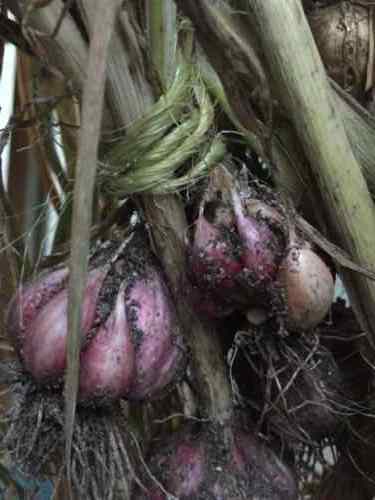 Check your garlic! It is getting close to harvest time (and I've seen on Facebook many have harvested their crop already). Depending on what variety you planted, and when, the tops may well be yellowing and have fallen over. Ideally, about a quarter of the leaves are still green. Do carefully run your fingers down the stem to check on the bulb development. 'Wet garlic' is when the bulbs are picked too soon. They need to dry off a little in the ground; it's this drying off process that allows the papery walls to form between the individual cloves. By carefully digging around your garlic (or harvesting one plant) you can gauge where your crop is at. Once harvested, don't wash the bulbs; hang or place on a wire rack and allow to dry in an airy place out of the sun for a couple of weeks. By all accounts these cloves (photo from last year) were left a little too long - the cloves are visibly separating already. Nothing wrong with that - but apparently they don't keep so well. (Not a problem for me - I froze the excess and enjoyed them for many months afterwards!)
Check your garlic! It is getting close to harvest time (and I've seen on Facebook many have harvested their crop already). Depending on what variety you planted, and when, the tops may well be yellowing and have fallen over. Ideally, about a quarter of the leaves are still green. Do carefully run your fingers down the stem to check on the bulb development. 'Wet garlic' is when the bulbs are picked too soon. They need to dry off a little in the ground; it's this drying off process that allows the papery walls to form between the individual cloves. By carefully digging around your garlic (or harvesting one plant) you can gauge where your crop is at. Once harvested, don't wash the bulbs; hang or place on a wire rack and allow to dry in an airy place out of the sun for a couple of weeks. By all accounts these cloves (photo from last year) were left a little too long - the cloves are visibly separating already. Nothing wrong with that - but apparently they don't keep so well. (Not a problem for me - I froze the excess and enjoyed them for many months afterwards!)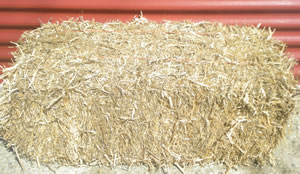 Mulch. Now is the perfect time to get some mulch down on your garden - before we have too many hot days is the perfect opportunity. If your soil is water repellent, a consider incorporating Sand Remedy, Cassies Clay, Charlie Charcoal (or a combination - we're happy to give advice) as these mineral elements are permanent ways to increase the water holding ability of your soil. The Water Corporation recommends using a chunky, coarse mulch ("one that would hurt to walk on with bare feet") at a depth of about 75mm. For vegetable gardens, most people prefer using a straw based mulch (because it's easier to use in regularly maintained gardens, and breaks down to add organic matter to the soil after a season). Talk to us about what your requirements are & we're happy to suggest options. Besides bales of pea straw [pictured right] and wheat straw, we have bagged products like 'Who Flung Dung' (a rich, feeder mulch inoculated with beneficial microbes), Sugar Cane Mulch - WA grown, and Lupin Mulch.
Mulch. Now is the perfect time to get some mulch down on your garden - before we have too many hot days is the perfect opportunity. If your soil is water repellent, a consider incorporating Sand Remedy, Cassies Clay, Charlie Charcoal (or a combination - we're happy to give advice) as these mineral elements are permanent ways to increase the water holding ability of your soil. The Water Corporation recommends using a chunky, coarse mulch ("one that would hurt to walk on with bare feet") at a depth of about 75mm. For vegetable gardens, most people prefer using a straw based mulch (because it's easier to use in regularly maintained gardens, and breaks down to add organic matter to the soil after a season). Talk to us about what your requirements are & we're happy to suggest options. Besides bales of pea straw [pictured right] and wheat straw, we have bagged products like 'Who Flung Dung' (a rich, feeder mulch inoculated with beneficial microbes), Sugar Cane Mulch - WA grown, and Lupin Mulch..JPG) Thin your stone fruit - it's tough to do, but it means you'll end up with larger and better quality fruit with the ones you leave on the tree. I'll remove one of each of the sets of two plums on this branch for example.
Thin your stone fruit - it's tough to do, but it means you'll end up with larger and better quality fruit with the ones you leave on the tree. I'll remove one of each of the sets of two plums on this branch for example. You're definitely not too late to plant summer crops from seed - this cycle of cold and rainy weather has certainly set things back a little, so if you're keen to get seeds going - give it a try! It's the perfect time of year for many vegetables and herbs - check out our When to Sow guides
You're definitely not too late to plant summer crops from seed - this cycle of cold and rainy weather has certainly set things back a little, so if you're keen to get seeds going - give it a try! It's the perfect time of year for many vegetables and herbs - check out our When to Sow guides 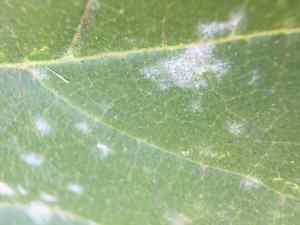
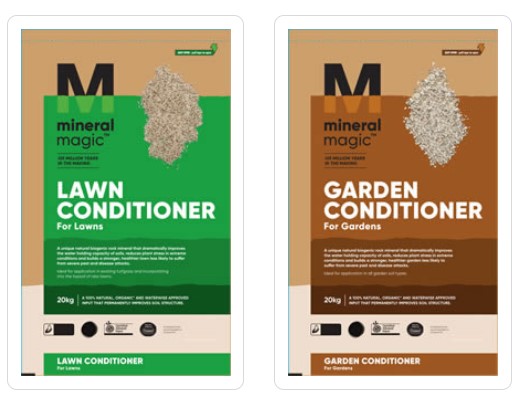 GLSC is now stocking MINERAL MAGIC. This is a granulated silica that comes in two grades - fine (for lawns) and a slightly coarser grade (for garden beds). What the product does is provide plant available silica - an important mineral that has been proven to increase the drought tolerance of plants, increase cellular strength (meaning reduced disease and pest attack), and improved nutrient and water holding in the soil itself.
GLSC is now stocking MINERAL MAGIC. This is a granulated silica that comes in two grades - fine (for lawns) and a slightly coarser grade (for garden beds). What the product does is provide plant available silica - an important mineral that has been proven to increase the drought tolerance of plants, increase cellular strength (meaning reduced disease and pest attack), and improved nutrient and water holding in the soil itself.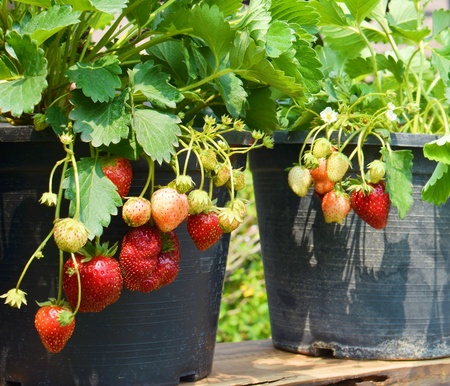 Who doesn't love juicy, fresh strawberries? (Well, my brother doesn't - but I think he might be the only one on the planet). Most of us love these sweet treats - and the good news is, they're relatively easy to grow. They do benefit from a little TLC, so here's some info on how to get the best from them.
Who doesn't love juicy, fresh strawberries? (Well, my brother doesn't - but I think he might be the only one on the planet). Most of us love these sweet treats - and the good news is, they're relatively easy to grow. They do benefit from a little TLC, so here's some info on how to get the best from them.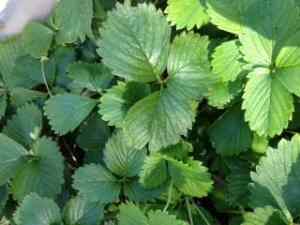 The thing you need to watch in pots, hanging baskets, or those strawberry planting towers you can buy is that they're more susceptible to drying out, and to wind damage in summer. Strawberries are shallow rooted, so one or two days of being too dry - and they'll turn their toes up on you. (Ask me how I know). I've had good success in wicking beds - in particular, the
The thing you need to watch in pots, hanging baskets, or those strawberry planting towers you can buy is that they're more susceptible to drying out, and to wind damage in summer. Strawberries are shallow rooted, so one or two days of being too dry - and they'll turn their toes up on you. (Ask me how I know). I've had good success in wicking beds - in particular, the 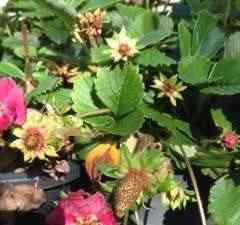 Strawberry plants will send out runners after fruiting - these are the way the plants reproduce & spread. If you're wanting the original plants to concentrate on bearing fruit, it is wise to remove these. Otherwise, allowing the first runner to take root, then transplanting it is a good way to keep the disease free plants reproducing and continuing. Usually, the first runner closest to the parent is the strongest; trim off and discard other plants to ensure survival of the fittest. Traditionally the original plants are replaced with the new generation - however you will get at least two years cropping from the original plants if you choose to leave them and continue to feed them.
Strawberry plants will send out runners after fruiting - these are the way the plants reproduce & spread. If you're wanting the original plants to concentrate on bearing fruit, it is wise to remove these. Otherwise, allowing the first runner to take root, then transplanting it is a good way to keep the disease free plants reproducing and continuing. Usually, the first runner closest to the parent is the strongest; trim off and discard other plants to ensure survival of the fittest. Traditionally the original plants are replaced with the new generation - however you will get at least two years cropping from the original plants if you choose to leave them and continue to feed them.  Thank you to everyone who's sent in garden photos! PLEASE keep 'em coming! We pick a winner at random each month, so persistence pays off. We LOVE to see what you're up to in your garden; it inspires us and helps us share the love with others.
Thank you to everyone who's sent in garden photos! PLEASE keep 'em coming! We pick a winner at random each month, so persistence pays off. We LOVE to see what you're up to in your garden; it inspires us and helps us share the love with others.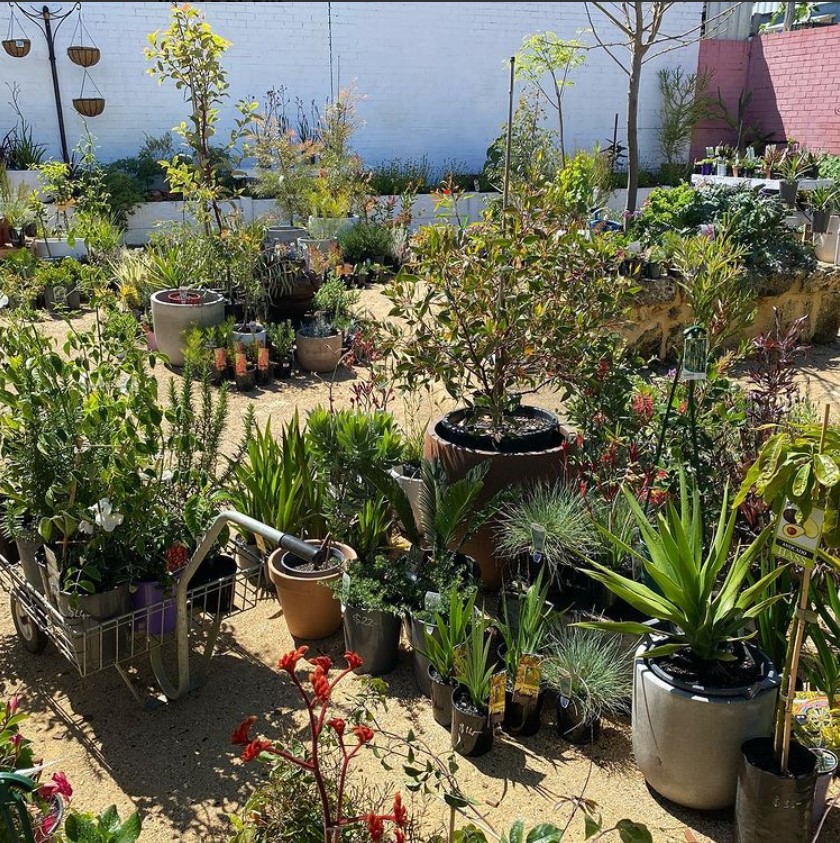 Beaufort Garden World - Inglewood 9271 0585
Beaufort Garden World - Inglewood 9271 0585